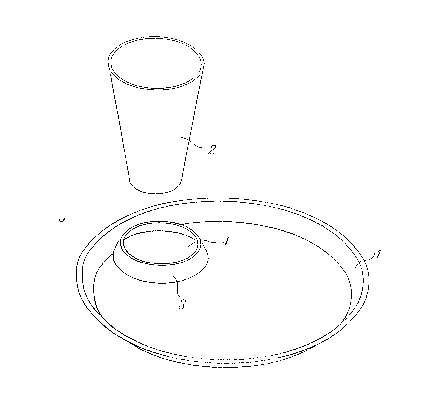Some of the information on this Web page has been provided by external sources. The Government of Canada is not responsible for the accuracy, reliability or currency of the information supplied by external sources. Users wishing to rely upon this information should consult directly with the source of the information. Content provided by external sources is not subject to official languages, privacy and accessibility requirements.
Any discrepancies in the text and image of the Claims and Abstract are due to differing posting times. Text of the Claims and Abstract are posted:
| (12) Patent Application: | (11) CA 2067604 |
|---|---|
| (54) English Title: | PLATE WITH MEANS FOR RECEIVING AND HOLDING A CUP |
| (54) French Title: | ASSIETTE PORTE-VERRE |
| Status: | Deemed Abandoned and Beyond the Period of Reinstatement - Pending Response to Notice of Disregarded Communication |
| (51) International Patent Classification (IPC): |
|
|---|---|
| (72) Inventors : |
|
| (73) Owners : |
|
| (71) Applicants : | |
| (74) Agent: | |
| (74) Associate agent: | |
| (45) Issued: | |
| (22) Filed Date: | 1992-03-25 |
| (41) Open to Public Inspection: | 1993-03-04 |
| Availability of licence: | N/A |
| Dedicated to the Public: | N/A |
| (25) Language of filing: | English |
| Patent Cooperation Treaty (PCT): | No |
|---|
| (30) Application Priority Data: | ||||||
|---|---|---|---|---|---|---|
|
ABSTRACT
A novel plate or dish for receiving and holding a cup
is disclosed and is particularly suitable at picnics, with take-
out meal services and when eating on moving vehicles such as
planes or trains. Further, the plates or dishes of this
invention and which include means for receiving and holding a cup
can be made, if desired, of any disposable material and can be
conveniently stacked one on top of the other for storage
purposes. The means for receiving and holding a cup located on
the plate or dish is in the form of an opening, or a recessed
surface of a raised surface on the plate or dish, or a
combination thereof. As an opening, it is preferably circular
so as to receivingly engage a conical cup; the circular opening
preferably being provided on a raised surface of the plate. The
plate may also be divided into several sections by means of
partition bars so that different food items, in addition to the
cup, can be placed in different compartments on the plate.
Note: Claims are shown in the official language in which they were submitted.
Note: Descriptions are shown in the official language in which they were submitted.

2024-08-01:As part of the Next Generation Patents (NGP) transition, the Canadian Patents Database (CPD) now contains a more detailed Event History, which replicates the Event Log of our new back-office solution.
Please note that "Inactive:" events refers to events no longer in use in our new back-office solution.
For a clearer understanding of the status of the application/patent presented on this page, the site Disclaimer , as well as the definitions for Patent , Event History , Maintenance Fee and Payment History should be consulted.
| Description | Date |
|---|---|
| Inactive: IPC from MCD | 2006-03-11 |
| Time Limit for Reversal Expired | 2000-03-27 |
| Application Not Reinstated by Deadline | 2000-03-27 |
| Deemed Abandoned - Failure to Respond to Maintenance Fee Notice | 1999-03-25 |
| Inactive: Abandon-RFE+Late fee unpaid-Correspondence sent | 1999-03-25 |
| Application Published (Open to Public Inspection) | 1993-03-04 |
| Abandonment Date | Reason | Reinstatement Date |
|---|---|---|
| 1999-03-25 |
The last payment was received on 1998-02-16
Note : If the full payment has not been received on or before the date indicated, a further fee may be required which may be one of the following
Patent fees are adjusted on the 1st of January every year. The amounts above are the current amounts if received by December 31 of the current year.
Please refer to the CIPO
Patent Fees
web page to see all current fee amounts.
| Fee Type | Anniversary Year | Due Date | Paid Date |
|---|---|---|---|
| MF (application, 6th anniv.) - small | 06 | 1998-03-25 | 1998-02-16 |
Note: Records showing the ownership history in alphabetical order.
| Current Owners on Record |
|---|
| CHI MAN LAM |
| Past Owners on Record |
|---|
| None |